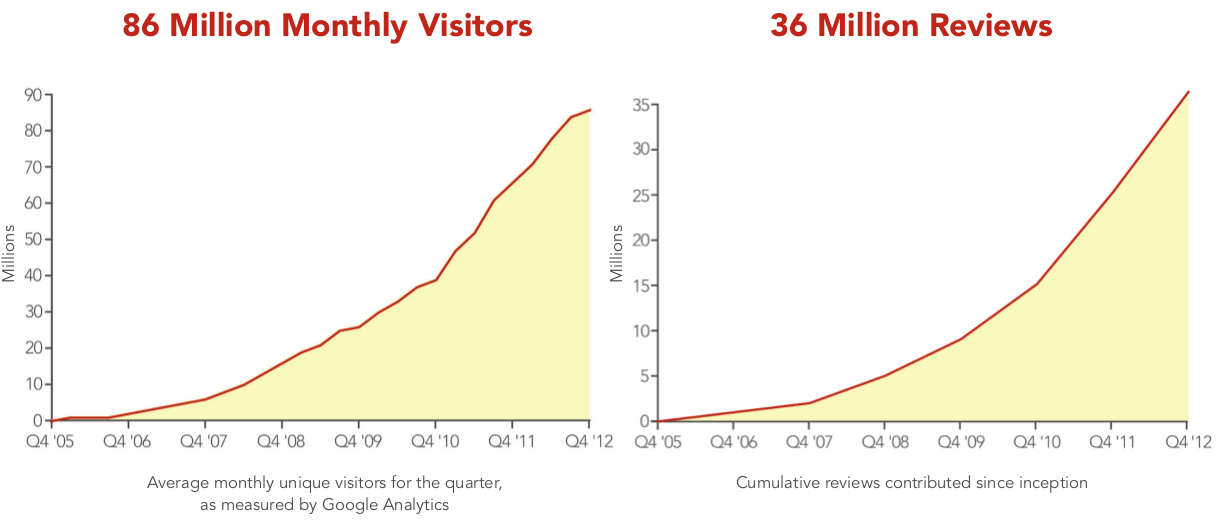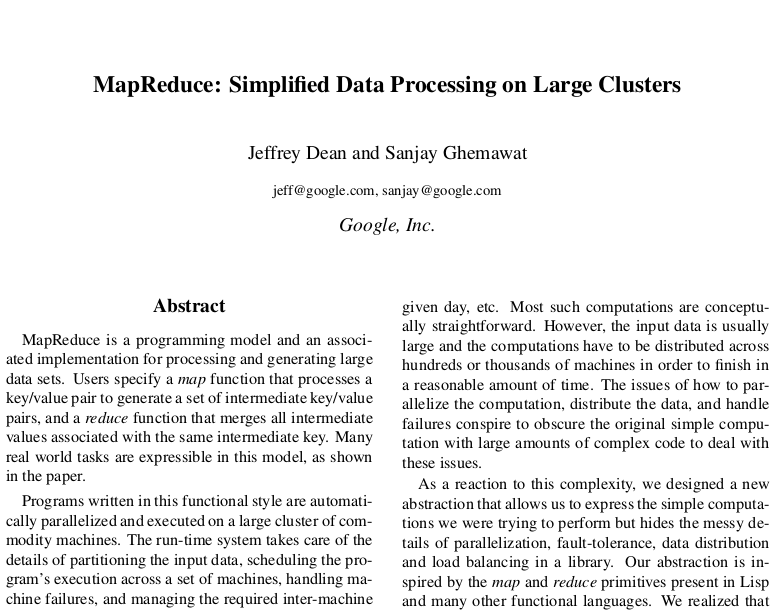2013-02-15-MapReduce
Table of Contents
1 MapReduce
1.1 Spoilers notes
- Don't look ahead in the slides
- If you know MapReduce, try to let others answer and genuinely think about how you would solve the problem.
2 Yelp has a problem
- 250+ GB of logs per day
- Each GB takes 10 minutes to process
- How long to handle a day's logs?

2.1 Too long notes
- On a single machine 40+ hours!
- If we really had only a single machine, we wouldn't be able to keep up!
- Mistake can't be fixed in a day (billing especially important)
3 Solution? animate
- Don't use one machine!
- What are the new challenges?
- Distributing data
- Calculating overall statistics
- Failures
3.1 New Challenges notes
- With many machines, how to they get access to the 100 GB of logs?
- How do they coordinate who gets which section of logs?
- How do we calculate the average?
- What happens when one of the boxes dies?
- Detecting failure (timeout waiting for data? Out of band?)
- Decide who takes over the data
4 Do It Yourself two_col
- There are many ways to deal with these challenges
- Often, people would "roll" their own solutions depending on the problem
- Google implemented a generic solution, shared idea

4.1 Dependencies notes
- Did you have a super-computer?
- What programming language were you using?
- Type of problem being solved (working on graphs, or web logs, …)
5 Big Idea
- Simplify, limit solution expression
- Enable sophisticated implementation
- Interface: Map() Reduce()
- Implementation: Reliably run over 1000s of machines
5.1 Really Big Idea notes
- Limiting yourself to what can be expressed may seem like a loss
- But it enables the implementation to handle the problems we talked about
- And then can be used as understandable building blocks
6 MapReduce
- Map
- Extract a property to summarize over
- Reduce
- Summarize all items with a particular property
- Simple: Each operation stateless
6.1 Reading notes
- Reading this week includes a video explaining MapReduce much more generally
- This lecture will focus on it from a practical standpoint for homework
- MapReduce's main benefits are for running over many machines, fault tolerance
- But we'll just practice on one machine
6.2 Example
- Web application logs
- How many actions have we seen?
- Business views
- User profile views
- Searches
6.2.1 Details notes
- Business Views
- Triple Rock, Bear Raman
- User profile
- jimblomo.yelp.com
- Searches
- query, location
6.3 Logs
{'page_type': 'search',
'user': 'jim', 'query': ...}
{'page_type': 'biz_view',
'user': 'shreyas', 'biz_id': 55}
{'page_type': 'user_profile',
'user': null, 'profile_id: 123}
...
6.3.1 Logs notes
- JSON logs, various types of information
- entire record on one line (wrapped for slides)
6.4 Map
- Input
- Key, Value
- Output
- Keys, Values
6.5 Map Example
- Input Key
- Log line number
- Input Value
- Log line text
- Output Key
- Action
- Output Value
- times this action has occurred on this line
6.5.1 Counts notes
- Log line number is not helpful in our specific case
- Log line text: we hope it is machine readable so we can accurately extract the action
- It has datetime, cookie, action, etc.
- How many times has this action occurred? 1
- Tunnel vision: all we care about is this line
6.6 Actions?
search 1 biz_view 1 user_profile 1 search 1 biz_view 1 search 1 biz_view 1 user_profile 1 search 1
6.6.1 Middle Step notes
- From log lines, we've extracted the information out that we care about
- The counts and the actions
- Next step summarize
- Next step after Map?
6.7 Reduce
- Input
- Key, Values
- Output
- Keys, Values
6.7.1 Values notes
- Note: The input is values! Plural
- Because we get a key and all of its associated values
- Remind me: what are we trying to get out of this computation?
- So what do you think the output keys are?
- Values?
6.8 Reduce Example
- Input Key
- Action
- Input Values
- Counts:
[1,1,1,1] - Output Key
- Action
- Output Value
- Total Count
6.8.1 Details notes
- Action is one of search bizview profileview
- To get total count, sum all of the counts
6.9 Example Output
- Output Key
- Action
- Output Value
- Total Count
"search" 4 "user_profile" 2 "biz_view" 3
7 Point?
- A lot of work for counting!
- More complex calculations can be done this way, eg. PageRank
- Stateless constraint means it can be used across thousands of computers
7.1 Details notes
- By only looking at keys and values, can optimize a lot of back-end work
- Where to send the results?
- What to do when a computer fails? (Just restart failed part)
7.2 Implementation
biz_view 1 user_profile 1 search 1 search 1 biz_view 1 search 1 biz_view 1 user_profile 1 search 1
7.3 Intermediate notes
- This was the situation after map
- Keys all jumbled
- What Hadoop does is sort them and distribute them to computers
7.4 "Shuffle"
biz_view 1 biz_view 1 biz_view 1 search 1 search 1 search 1 search 1 user_profile 1 user_profile 1
7.5 Distribute notes
- Now it is easy to distribute, and can handle all the
biz_viewat once
7.6 Inputs
- MapReduce distributes computing power by distributing input
- Input is distributed by splitting on lines (records)
- You cannot depend on lines being "together" in MapReduce
7.6.1 Splitting Files notes
- Image you have a lot of large log files, GB each
- You'd like to let different machines work on the same file
- Split file down the middle, well, at least on a newline
- Enable two separate machines to work on the parts
- You don't know what line came before this one
- You don't know if you will process the next line
- Only view is this line
- Real life slightly more complicated, but mostly hacks around this
8 Word Count
{"text": "Greatest pizza ever", "stars": 2, "user": ...}
{"text": "good pizza selection", "stars": 5, "user": ...}
- Total uses of a word in across all reviews
8.1 Classic notes
- This is the traditional MapReduce example, so let's solve it
- No skipping ahead
9 Steps animate
- Map
- Extract
text - Count words in that review
- Key: word , Value: count
- Reduce
- Key: word , Values: all counts
- sum(values)
9.1 Hints notes
- What's the first step (of MapReduce)
- What part of the record are we interested in?
- What do we want with those words?
- Mapper: Key Value? What are we grouping by?
- Next step (of MapReduce)
- What are the reducer inputs
- with all of these counts, how do we summarize
9.2 Examples animate
- "Greatest pizza ever"
- Counts
- Greatest: 1
- pizza: 1
- ever: 1
- Reducer, Key: pizza
- Values: [1, 1]
- Output: ["pizza", 2]
10 Multi-Step
- Not all computations can be done in a single MapReduce step
- Map Input: <key, value>
- Reducer Output: <key, value>
- Compose MapReduce steps!
10.1 Output as Input notes
- The output of one MapReduce job can be used as the input to another
10.2 Examples
- PageRank: Multiple steps till solution converges
- Multi-level summaries
10.3 PageRank notes
- PageRank is an algorithm for calculating the important of a page
- But it depends on the importance of every page pointing to it!
- So iteratively calculate the important of all pages
- Find average presidential donations by candidate, then normalize averages
11 Unique Review animate
- Review ID with the most unique words
- Map Input: <line number, text>
- Map Output: <word, review_id>
- Reducer Input: <word, [review_ids]>
- Reducer Output: <review_id, 1> if the word is unique
11.1 Questions notes
- For our purposes, what is always the mapper input?
- What feature do we want to calculate first?
- Given this mapper output, what must the reducer input be?
- What property about a review are we interested in?
11.2 Step 2: Count Unique Words animate
- Map Input: <review_id, 1>
- Map Output: <review_id, 1>
- Reducer Input: <review_id, [1,1,…]>
- Reducer Output: <review_id, sum>
11.3 Questions notes
- Given the reducer output, what must the mapper input be (for chained MapReduce steps)
- What do we want to group by?
- Given this mapper output, what must the reducer input be?
- What are we calculating?
11.4 Step 3: Max animate
- Map Input: <review_id, sum>
- Map Output: <"MAX", [sum, review_id]>
- Reducer Input: <"MAX", [[sum, review_id],…]>
- Reducer Output: <review_id, sum> of the max(sum)
11.5 Questions notes
- Given the reducer output, what must the mapper input be (for chained MapReduce steps)
- We're calculating a statistic over what portion of the data set?
- What stat are we calculating?